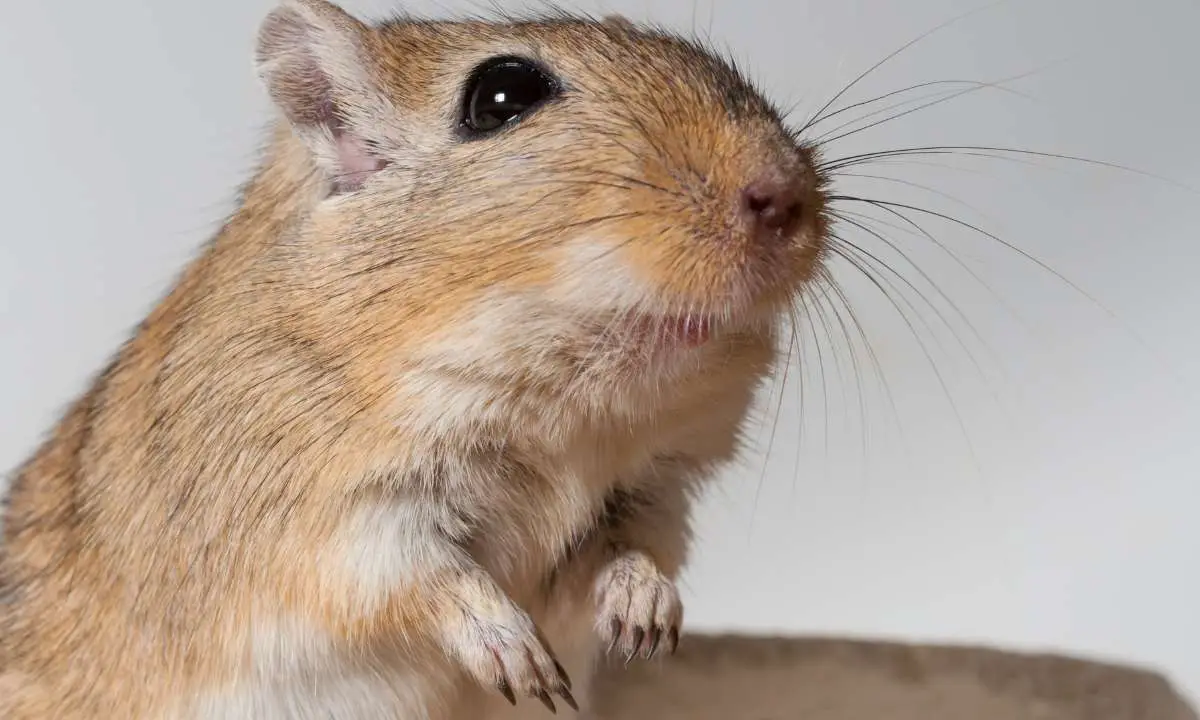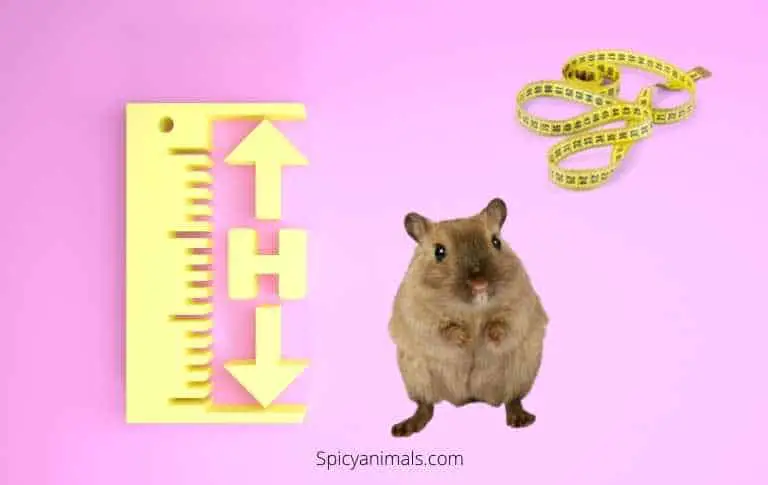Head Tilt in Gerbils is a condition of the inner ear that can cause gerbils to move in circles or tilt their head at an angle. This condition is caused by a cyst-like growth in the ear, which cannot be reversed once it has developed.
Treatment for this condition includes antibiotics as a precaution against infection, providing the gerbil with a low-stress home and plenty of soft bedding to cushion them when they move around, and monitoring their diet to ensure they are receiving all the vitamins and minerals they need.
With proper care, gerbils with Head Tilt can still live happy and healthy lives.
Table of Contents
Signs and Diagnosis
Gerbils, particularly Mongolian gerbils, are small, energetic rodents that make captivating pets. Their active nature can be amusing to observe, but it’s crucial to stay aware of any changes in their behavior. One such condition to watch for is head tilt, a common occurrence, especially in older gerbils.
Head tilt in gerbils is a condition where the gerbil is holding its head at an unusual angle, typically due to complications with the inner ear or brain. This abnormal posture may be caused by a variety of factors, including bacterial or viral infections, trauma, or even tumors such as an aural cholesteatoma in the ear canal.
The common signs of head tilt in gerbils encompass an unusual head angle, loss of balance, walking in circles, and difficulty eating or drinking. If you notice your gerbil losing its balance or struggling to walk or run in a straight line, these could be indications of head tilt. Additional signs may include eye or ear discharge, which can aid in diagnosis.
When such symptoms occur, it’s critical to take your gerbil to the vet for an accurate diagnosis. Diagnostic tests like X-rays, CT scans, or bloodwork may be administered to pinpoint the underlying cause of the head tilt. Depending on these results, the treatment may include antibiotics such as Baytril, anti-inflammatory injections to reduce any inflammation, fluids, and nutritional supplements.
Maintaining vigilance towards any changes in your gerbil’s behavior is paramount to catching health issues early on, ensuring your gerbil gets the necessary treatment promptly.

What Causes head tilt
Head tilt is a condition commonly seen in gerbils and can be triggered by various causes. Conditions such as cholesteatoma, infections, tumors, neurological disorders, trauma, and even exposure to parasites can all lead to head tilt in gerbils.
Symptoms often include an abnormal head position, difficulty walking or balancing, circling behavior, or, in severe cases, seizures. Diagnosis typically involves a physical examination and imaging tests such as X-rays or CT scans.
Treatment options, dependent on the underlying cause, can range from antibiotics for infections, surgery to remove tumors or cholesteatomas, medications to manage seizures or other neurological symptoms, and supportive care like fluids and nutritional supplements.
Risk factors that may increase the likelihood of head tilt include age (gerbils over two years old are more prone), genetics (certain breeds are predisposed), poor husbandry practices (like overcrowding), and exposure to parasites.
In conclusion, owning a gerbil requires a measure of awareness and care. Regularly monitor your pet for any changes and ensure it gets timely veterinary treatment if symptoms of head tilt appear. This active observation can help provide your gerbil with the most comfortable and healthy life possible.
Treatment Options
If you observe your gerbil exhibiting signs of distress or ill health, it’s crucial to get your gerbil to a vet for immediate treatment and accurate diagnosis.
Once your gerbil has been diagnosed, there are several measures you can take to ensure their comfort during the healing process. Providing essential needs such as food and water, as well as comfortable bedding
– old t-shirts work well –
is vital to your gerbil’s well-being. Depending on the specific condition, additional treatments may also be required.
These might include antibiotic or antifungal medications, surgery, or even physical therapy if your gerbil has lost its balance due to a condition like head tilt, which is common in older gerbils.
It’s paramount to adhere strictly to your veterinarian’s instructions and complete the full treatment regimen to ensure the best outcome for your pet. As the condition progresses, you may need to adapt the care you provide, which could involve feeding your gerbil by hand if they’re struggling to eat or excessive cleaning of their living space to prevent reoccurring infections.
Be mindful of potential side effects or risks associated with different treatment options. This will help you make informed decisions about what’s best for your gerbil.
For example, if your gerbil is suffering from a chronic, painful condition and temporary relief measures are not effective, you might want to discuss more permanent solutions with your vet. Sadly, in some cases, euthanasia may be the most humane option.
Fortunately, many gerbil ailments, like all animal health issues, are treatable. With timely veterinary intervention, your delicate pet can recover and return to its normal, active self.
However, it’s essential to remember that the path to recovery may be a slow one, requiring patience and persistent care.
Prognosis and Long-Term Care
Head tilt in gerbils is a health problem that affects the brain or ears and can cause the animal to appear off-balance. It is important for owners to recognize the symptoms of head tilt and take their gerbil to the veterinarian for diagnosis and treatment as soon as possible.
The most common causes of head tilt in gerbils are inner ear infections, tumors, cysts, trauma, or parasites. Symptoms may include balance issues, tilting of the head, circling, or difficulty walking.
To diagnose head tilt in gerbils, a veterinarian will perform a physical exam and may order additional tests such as x-rays or blood work.
Treatment options for head tilt depend on the underlying cause but may include antibiotics for bacterial infections, anti-parasitic medications for parasites, surgery to remove tumors or cysts, and supportive care such as fluids and nutrition supplementation.
The prognosis for recovery from head tilt depends on the severity of the condition and how quickly it is treated; however, with prompt veterinary care many gerbils can make a full recovery.
After treatment has been completed it is important to continue providing long-term care for your gerbil with head tilt. This includes providing a safe environment free from stressors such as loud noises or sudden movements that could cause further injury or illness.
Additionally, regular check-ups with your veterinarian can help monitor any potential long-term effects of head tilt such as hearing loss or vision impairment that can be managed over time with appropriate treatments.
Overall, recognizing symptoms early and seeking prompt veterinary care is key to ensuring a successful recovery from head tilt in gerbils. With proper diagnosis and treatment along with continued long-term care post-treatment, many gerbils can live happy lives despite this condition.
Prevention
Gerbil owners should take preventive measures to avoid head tilts and other illnesses in their pets. The most important thing is to maintain a clean living environment for your gerbil. This means regularly cleaning the cage and replacing soiled bedding as soon as you notice it.
Additionally, it’s important to avoid rough play or handling of your gerbil, as this can increase the risk of illness.
It’s also important for gerbil owners to be aware of the warning signs that could indicate potential problems with their pet’s health.
These include changes in behavior such as lethargy or disinterest in food, as well as physical symptoms like labored breathing or an unbalanced walk (which could indicate head tilt). If you notice any of these signs, it’s important to seek professional veterinary assistance right away.
If your gerbil does develop head tilt or another illness, there are treatment options available.
Depending on the severity and cause of the illness, your veterinarian may prescribe medications or suggest lifestyle modifications such as providing a low-stress environment and avoiding over-handling. In some cases, surgery may be necessary to correct certain conditions.
Overall, taking preventive measures such as maintaining a clean living environment and monitoring your pet’s health and behavior can help minimize the risk of head tilt and other illnesses in gerbils.
If you do notice early signs of disease or head tilt in your pet, it’s important to seek professional veterinary assistance right away for proper diagnosis and treatment.
Anatomy and Physiology of Gerbils
Gerbils are small, social rodents that have become popular as pets due to their playful and curious nature. While they may seem like simple creatures, gerbils have a complex anatomy and physiology that can be difficult for owners to understand.
One of the most important aspects of gerbil anatomy is their inner ear and neurological system. This system is responsible for balance, coordination, and movement.
It also plays a role in head tilt, a common symptom in gerbils that can cause them to walk in circles or fall over when standing still. In order to prevent head tilt, it’s important for owners to provide their gerbils with an enriched environment that includes plenty of exercise and stimulation.
Another important aspect of gerbil anatomy is their teeth. Like all rodents, gerbils have front teeth (incisors) that constantly grow throughout their lives.
If these teeth are not worn down by hard objects such as chew toys or treats, they can become overgrown and cause problems with eating and drinking. To prevent this from happening, it’s important for owners to provide their gerbils with plenty of chew toys and other objects that will help keep their teeth at the right length.
Finally, it’s important to understand the intricacies of the gerbil digestive system in order to ensure your pet’s health and well-being. Gerbils have a water-conserving physiology which means they produce very dry feces and small amounts of highly concentrated urine.
This means they need access to fresh water on a daily basis in order to stay hydrated. Additionally, it’s important for owners to provide their gerbils with a balanced diet consisting of high-quality pellets supplemented with fresh fruits and vegetables in order to ensure proper nutrition.
Overall, understanding the anatomy and physiology of gerbils is essential for providing them with the best care possible.
By taking into account the unique aspects of their inner ear and neurological systems, teeth, and digestive systems, owners can ensure that their pet stays healthy and happy for years to come!
Tips for gerbils with head tilt
Gerbils are fun and active pets that require a bit of extra care. To ensure your gerbil stays healthy and happy, it’s important to provide a healthy diet, regular exercise, and socialization.
A healthy diet for gerbils should include rodent pellets, small amounts of grain, vegetables, fruits, hay, and fresh water daily. It’s also important to avoid giving them too many treats as they can quickly become overweight.
Gerbils need plenty of exercises to stay fit and active.
Providing them with an exercise wheel or other toys is a great way to keep them entertained and get their daily exercise. Additionally, you can let your gerbil out of its cage for supervised playtime in a safe area.
Finally, gerbils are social animals that need companionship from their owners and other gerbils. If you have more than one gerbil in the same cage, make sure they get along well before introducing them.
Otherwise, spend some time interacting with your pet each day so they don’t feel lonely or neglected.
By following these tips for proper care of your pet gerbil, you can ensure they stay healthy and happy for years to come!
Warnings
Gerbil owners should be aware of the risks and complications associated with head tilts. Head tilting in gerbils can be caused by a variety of conditions, including ear cysts, middle ear infections, brain tumors, or nerve damage.
If left untreated, these conditions can lead to hearing loss, difficulty eating and drinking, and even inability to move.
Regular check-ups are key for prevention. Gerbil owners should look out for signs of head tilting such as an inclination of the head or difficulty moving around.
If any of these symptoms are observed, it is important to seek veterinary attention as soon as possible.
If you suspect that your gerbil may have a head tilt, there are several steps you can take right away: make sure your gerbil has access to fresh water and food; keep the cage clean; and provide a safe environment with plenty of hiding places.
Additionally, if you notice any changes in behavior or physical appearance in your pet gerbil, contact your veterinarian immediately for further evaluation and treatment options.



